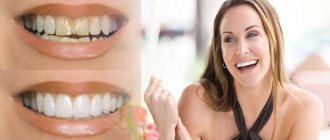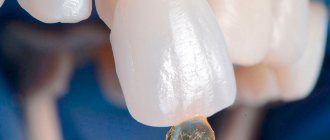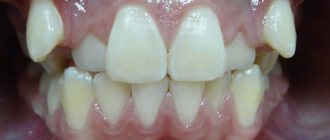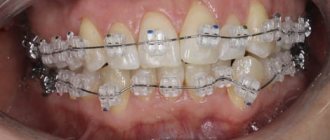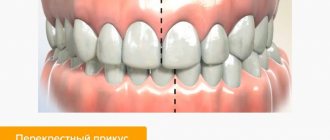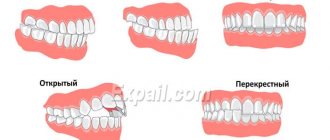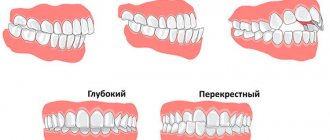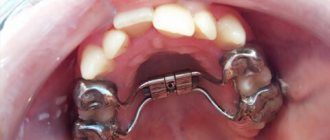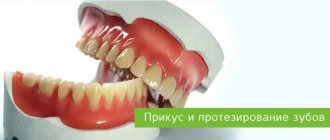To correct an abnormal bite, you can put braces on your teeth. Such orthodontic systems affect bone tissue, muscles and ligaments, and help slowly move teeth into the correct position. Many people are interested in the question: is it possible to put braces on one jaw? You will find the answer in this article.
In this article
- What are braces?
- Are braces placed on one jaw?
- Main indications for partial correction
- Orthodontic correction up to 12 years
- Braces for the lower jaw only for mild crowding
- Treatment for crowded upper anterior incisors
- Closing the gap between the front incisors
- Partial bracket system for preparation for prosthetics
- Absence of chewing teeth on the opposite jaw
- Should I install braces on one jaw or not?
What are braces?
A brace system is an orthodontic device that is installed on the teeth and helps them move in the desired direction. Structurally, this device consists of small plates (directly braces), which are glued to the dental crown at pre-calculated points, and a metal arch. This arc has shape memory and is an active element of the system. Fixed on the plates, it tries to regain its even position and thereby puts pressure on the teeth. As a result, their slow, gradual movement in the bone tissue occurs. Orthodontic treatment not only helps to correct the curvature of individual teeth in a row, it allows you to change the shape and position of the jaw, and restore facial symmetry.
It is preferable to begin orthodontic correction in childhood. But modern medical capabilities make it possible to carry it out even in adulthood and old age.
Most often, an orthodontic device is placed on two jaws at once. The dentist calculates in advance in which direction a particular tooth should move, how much it is necessary to expand the jaw or spread the dentition. Double-jaw treatment is comprehensive and allows you to solve global problems in occlusion correction. It usually takes from several months to several years.
Orthodontic aligners as an alternative to braces: when can they be used and how much does installation cost?
If the diagnosis does not reveal significant malocclusions, you can refuse braces and straighten your teeth with aligners. Aligners, unlike braces, are removable designs - you can easily remove and put on the aligners at home, as needed. Mouthguards are made from polymer and completely transparent material, and therefore they will be invisible on the teeth.
Mouthguards for bite correction can be either standard or individual, and it is the latter design option that is recognized by orthodontists as the most effective. Individual mouth guards are made using an impression of the patient’s teeth and using three-dimensional modeling technology, so they will be comfortable for everyday wear and will help correct the bite faster (compared to standard factory mouth guards).
To correct your bite, you will need not just one mouth guard, but a whole set of orthodontic structures that are made individually for each patient. The price of such a set of mouth guards in our Firadent dentistry will be from 150,000 rubles
.
Using aligners to correct your bite does not mean that you will have to do everything yourself, and visits to the orthodontist for routine examinations are not necessary. It is necessary to visit a specialist during the course of correction - it is the doctor who will tell you when it is time to replace the aligners with the next model from the kit. Scheduled follow-up visits are not included in the cost of installing aligners and may increase the cost of treatment.
As you can see, the cost of installing mouth guards is not cheaper than the price of treatment with braces. You also need to take into account the fact that correction with mouth guards will require discipline on your part: if you wear mouth guards on your teeth less than expected and constantly remove them, you can’t count on a positive effect in correcting your bite.
Are braces placed on one jaw?
Installing a brace system is one of the most common and effective methods for correcting an abnormal bite, improper closure of the teeth of the upper and lower jaw. Crooked teeth and abnormal jaw position not only spoil a person’s appearance, but also affect his health. Therefore, correcting the bite is important and necessary. But installing braces confuses many people.
Some are concerned about aesthetics, others are concerned about possible inconveniences when wearing the system, others simply want to save on orthodontic correction. And then the patient turns to the doctor with the following question: is it possible to install braces only on the upper jaw or only on the lower jaw.
As a rule, a person knows in advance which teeth he wants to change. And if they are located only on one jaw, then he expects that he will have a partial braces installed, only in the area of the curvature.
The doctor must make such a decision. It may seem to the patient that he has a problem only with the lower jaw, but the dentist sees during the examination that partial correction will not give an effective result. In this case, the orthodontist will insist on a complete correction. If you need a stable result of orthodontic treatment, we recommend listening to the professional opinion of an orthodontist.
Self-regulating braces design reviews
From my own experience, I can say that for the majority of patients, adaptation is quick and painless. After getting used to it, there are no problems with cleaning and eating. All patients are satisfied with the results of the treatment, except for those cases when people think that they overpaid for the design and it was not worth the money. Regarding this, I can say one thing: all designs have their place in modern orthodontics, and choosing a budget design is not always the worst option. At the LeaderStom clinic, our specialists will advise you on any issue on this or any other topic, and will also give you back a beautiful smile.
Main indications for partial correction
In some cases, it is indeed possible to place braces on one jaw, and this approach will be effective. As a rule, these are situations where the teeth are only crooked at the top or bottom, but the bite is not broken and there is no facial asymmetry. Partial correction may be recommended for the following indications:
- one or two teeth are positioned incorrectly;
- slight crowding of teeth (lack of space - up to 3 mm);
- a gap between the front incisors in the absence of pathological closure of premolars and molars;
- correction of the position of teeth before installing dentures;
- the need to avoid sagging of the upper teeth when their antagonists (opposite units) in the lower jaw are absent.
Diagnostics will show how effective braces will be only on the upper jaw or, conversely, on the lower jaw. It should include a visual examination, x-rays, assessment of the condition of bone tissue and dental roots.
Let's consider cases when it is justified to place braces separately on the upper jaw and separately on the lower jaw.
Orthodontic correction up to 12 years
Braces are primarily used for children starting in their teens. This is due to the fact that by the age of 11-12 years the formation of the jaws is completed, and the primary bite is replaced by a permanent one. But often, an orthodontist discovers bite problems in a child at an earlier age. Installing partial braces helps solve some of them, as well as prepare teeth for further correction in adolescence.
The doctor can place an orthodontic device on one jaw or individual teeth in order to:
- create space for the eruption of permanent teeth;
- expand one of the jaws;
- close the gap between the front incisors (the so-called diastema);
- correct the incorrect position of one or more teeth that are bothering the child;
- preserve the space left after early removal of baby teeth, which neighboring ones are trying to occupy.
Thus, braces can be placed on one jaw at the age of 9-10 years to solve a specific orthodontic problem. In this case, in adolescence, further, already double-jaw, treatment will be required.
Five factors that influence how long you wear braces
The total time that patients wear braces is 1-3 years. How many months or years it will take in your case can only be predicted by an orthodontist (after examination and medical history). In advance, you can independently calculate the approximate time for which the structures are worn, taking into account five main factors:
- Patient's age.
- Type and complexity of violations.
- Type of bracket system.
- Qualification of an orthodontist.
- Care and implementation of recommendations.
Each of the factors has its own characteristics, which are worth considering in more detail.
Patient age
The specific time of use after installing braces is determined based on the clinical picture and individual characteristics of the jaw structure. But, you can rely on average data that is natural for different ages of patients:
- Children
. Due to the pliability of the dentofacial apparatus, which occurs at the age of 12-16 years, all processes to correct the bite occur quite quickly. Most often, 0.5-1 year is enough to correct moderate severity. - Teenagers
. During the period of active formation of the dental system, you can count not only on the effectiveness of the result, but also on the minimum time to achieve it. On average, adolescents aged 18-23 years need 3-8 months less to achieve the desired result than older patients. - Adults
. Since in an adult the dentofacial apparatus is already fully formed, regenerative processes in tissues are slowed down and the rate of metabolic processes decreases, orthodontic treatment will take 2-3 years.
The question of how long braces should be worn may also arise in older people - the use of these orthodontic structures can be shown as one of the preparatory stages before prosthetics. In this case, you will have to wear braces for several years.
Type and complexity of violations
Braces can solve a number of problems with bite and uneven teeth. Depending on the reasons why you are installing orthodontic structures and the severity of the defect, the time for using braces may vary:
- Alignment of one or more teeth
. If it is necessary to shift (change the position) of units in a row, you will have to wear braces for an average of 1.5 years. - Elimination of distal bite
. This pathology can be diagnosed with different stages of complexity. Depending on the severity of the defect, wearing orthodontic structures lasts 1-3 years. - Elimination of diastema
. If the gap between the incisors is not a cosmetic defect and does not require masking (for example, with veneers), but treatment, then the doctor will prescribe braces. How long it takes depends on the age of the patient. The average period is 1-2.5 years. - Correction of deep bite
. One of the most difficult cases that braces can solve. In childhood this will take about 1.5 years, and for adults – up to 3 years.
In the case of crowded teeth, dystopia and other dental defects that require the use of braces to resolve, the time frame is determined individually and varies between 1.5-3 years.
Type of bracket system
The chosen type of braces also influences how long to wear orthodontic systems:
- By material
:
Metal
. The strongest modern system that applies optimal pressure to tissue. It is used to correct even complex defects within a period of 1-1.5 years. - Plastic
. They are fragile and require the utmost care. You will have to wear these braces for 12-18 months. - Ceramic
. Durable and do not cause allergies. Used to correct simple defects. Requires extended wear time - up to 3 years. - Sapphire
. They require particularly careful oral care. The impact of such systems lasts 1.5-3 years.
:
- Lingual
. They are attached to the inner surface of the teeth. Used for 1.5-2.5 years.
. They are attached to the outer surface of the teeth. Used for 1-2 years.
:
- Ligatures
. The design allows you to work more accurately and with greater force on difficult areas. Accordingly, the wearing time is as short as possible - up to 1.5 years.
. They are worn longer than ligature ones - up to 2.5 years. This option is chosen by those who, while wearing braces, care about the aesthetics of their smile, and who are willing to sacrifice extra time wearing the system for the sake of beauty.
Most often, patients are shown several options for braces, from which they can choose the one that suits its appearance and price. Not the last factor will be how long you will have to wear braces and whether you are willing to deliberately increase the wearing time for the sake of aesthetics or want to correct the defect in the shortest possible time.
Qualification of an orthodontist
The time that you will have to wear the brace system and obtaining the desired result directly depend on the experience and qualifications of the specialized doctor:
- At the consultation stage
. It is important to get the right advice on choosing a brace system based on your clinical case. Not only indications, but also contraindications should be taken into account. - At the preparation stage
. A lot depends on the quality of taking impressions and setting the task for the laboratory specialist. Only an experienced orthodontist will be able to do all the preparatory steps correctly. - At the installation stage
. The braces themselves are attached strictly to certain places and at a certain angle - depending on the position and inclination of the teeth. The doctor’s lack of relevant experience will increase the time of wearing the orthodontic structure and will not give the desired effect of treatment at all.
By choosing the right clinic and specialist, you increase your chances of getting a perfect smile and a healthy bite as quickly as possible.
Care and implementation of recommendations
Keep in mind that how long you need to wear braces depends on your responsibility. For example, a late visit to change wires may stop or slow down treatment. And an irresponsible attitude towards oral hygiene can lead to the development of caries and other diseases, which will require immediate solutions to problems. And, since braces can interfere, they will have to be removed, reducing to zero all the results achieved so far. The chipping of one of the braces can also increase the wear time - while the analogue is being made, the result will slow down or stop altogether.
Not only failure to follow the recommendations of an orthopedic dentist, but also force majeure situations can lead to early removal of orthopedic structures. For example, the occurrence of allergic reactions to the design (most often to metal models) or the need for a surgical solution to correct the anomaly.
If you take the orthopedist’s recommendations responsibly and visit the clinic in a timely manner for the necessary manipulations with the arches, then you will be able to wear braces for the shortest possible time.
You might be interested in:
Installation of braces
Bite correction
Self-ligating braces
Damon Clear bracket system
Damon Q braces
Ligature braces
Clear braces
Removing braces from teeth
Braces for the lower jaw only for mild crowding
Crowding is the position of teeth when they are too close to each other. As a result, rotation, curvature, and “layering” of each other occur. If slight crowding is observed only on the lower front incisors, while the upper front incisors are positioned evenly and the lateral ones close correctly, in this case, braces are sometimes placed only on the lower jaw. An important condition for this method is that there must be enough space to move horizontally so that the teeth can take the correct position. This treatment method is chosen in cases where the lack of space for alignment is less than 3 mm. With this method, separation of the front incisors is almost always performed - that is, minor grinding of the contact surfaces, which allows you to free 0.25 mm from each surface and in total create those missing 1-3 mm for alignment in the dentition.
At what age does it make sense for adults to get braces?
In any case, there are no age restrictions. There are surmountable obstacles: the general condition of the teeth, periodontal and gum diseases, and possible common concomitant diseases. Absolute contraindications for installing braces for adults coincide with many other types of treatment: lack of teeth, tuberculosis, diabetes, a number of immune diseases, epilepsy, bone pathologies, blood diseases. If a person gets braces when he is over thirty, the treatment will be quite long, since tissue regeneration occurs more slowly due to age. Plus, skeletal growth has already been completed, and the position of the bones can be “corrected” only when they are still growing - in childhood and adolescence. However, dentists achieve excellent results with mature patients.
Treatment for crowded upper anterior incisors
Braces on the upper jaw only can be placed if crowding is observed on the upper front incisors. The conditions are the same - the space deficit should be no more than 2-3 mm. In addition, treatment should not require expansion of the dentition. In this case, for orthodontic correction it is not necessary to involve the lower dentition.
If you provide space for uneven teeth by expanding the upper row, this will disrupt the closure. As a result, the teeth will “seek contact” with each other, the upper row will become narrow again, and in the long term the goal of orthodontic treatment will not be achieved. Therefore, if it is necessary to expand the upper row of teeth in order to correct crowding, a partial braces system cannot be used; a two-jaw apparatus will have to be installed. Braces can only be placed on the upper jaw if space for teeth is freed up using the separation method (their width is reduced by grinding the contact surfaces).
Closing the gap between the front incisors
Braces can be placed on the lower jaw if there is a large gap (diastema) between the lower front incisors. In this case, several conditions must be met:
- the lateral teeth close together normally;
- there is an opportunity for a “joint to joint” closure of the front teeth of the upper and lower rows.
If these conditions are not met, it may be necessary to artificially increase the size of those teeth between which there is a gap. This is done using filling material. If the patient is not ready to fill healthy teeth in order to increase their size, then single-jaw treatment of diastema will not suit him, since the doctor will not be able to guarantee the stability of the result.
Partial bracket system for preparation for prosthetics
Sometimes braces are placed on only one jaw in preparation for prosthetics or in order to close empty spaces from extracted teeth. In the first case, braces help change the angle of the teeth to make room for an implant or bridge. In the second case, the brace system is used to move the posterior chewing tooth to the place of the previously removed one, thereby closing the empty gap and avoiding prosthetics. It is important to note that such treatment is usually complex and lengthy (tooth movement can take up to four years).
The orthodontist decides how appropriate it is to install a partial brace system for such indications in each specific case.
Costs for follow-up visits to the orthodontist after braces are installed
After installing braces, you need to regularly visit the orthodontist’s office to evaluate the results of treatment and correct the arch of the system, replace structural elements that are worn out or damaged. The frequency of visits will depend on the type of braces; if you choose a self-ligating system for installation, you will need to come to the clinic once every two months.
Control visits are not included in the price of installing braces and are paid separately. The cost of a planned visit to the orthodontist in our clinic depends on the set of measures that will be carried out during braces correction.
Should I install braces on one jaw or not?
If the patient is concerned about the question of whether braces are placed on the lower jaw, then the answer will be positive. An orthodontic device can be installed not only on the lower or upper jaw, but also on individual teeth or areas of the dentition. But the main question is whether such treatment would be advisable. As a rule, installing a brace system on one jaw solves exclusively local dental problems. This process is more difficult to control and provides fewer treatment options. If contraindications are not provided, even a successful result will be short-lived, and the teeth will return to their previous position.
Thus, a dentist planning single-jaw orthodontic treatment must carefully assess the risks, take into account the many factors that will influence tooth movement and predict in advance the effectiveness and stability of the result.
If the doctor sees that solving the problem with a partial braces system will be problematic, he will recommend double-jaw treatment to the patient. Its advantages are that teeth can move in different planes without negative effects such as disruption of contacts between the upper and lower ones. Plus, such treatment is easier to predict and control, and it gives a more sustainable result.
Brief summary
How long you wear braces on your teeth depends on many factors. The summary table will help you navigate the average time frame, depending on the existing defect that requires correction:
| Deadlines | Defect requiring correction |
| 1-1.5 years | Correction of minor anomalies:
|
| From 2 years | For severe pathologies:
|
| Up to 3 years or more | Correction of the most serious and even rare defects, some of which require preliminary surgical intervention. |
Do not forget that after removing the braces, the treatment does not end, since from this moment the retention stage begins. Its duration can vary from 3-6 years, and in particularly difficult cases - throughout life.
